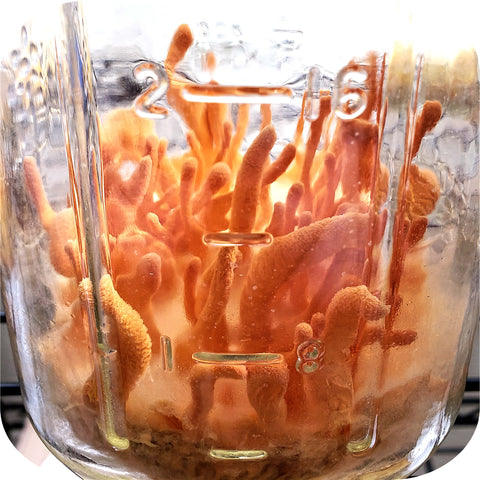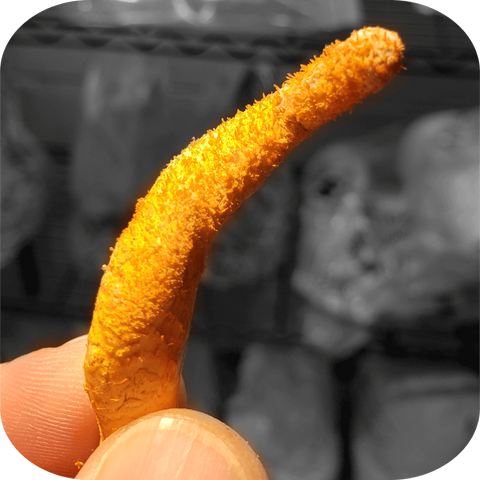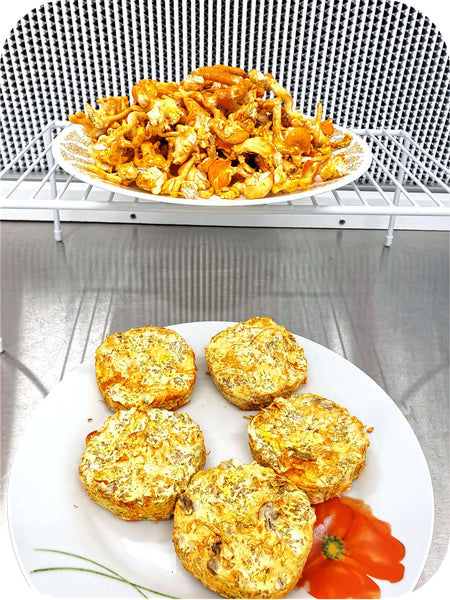How to Grow Cordyceps militaris (with recipes!)
Growing Cordyceps militaris is pretty easy. You don’t need a flow hood, wood substrate, or a lot of space. If you can maintain the temperature between 60 and 70 degrees F for 3 months, you already have the hardest part covered. This mushroom colonizes and fruits at the same temperature and will “fuzz over” or “re-myceliate” if the temperatures rise above 70 degrees F. Basically, the orange “Cheetos” looking mushrooms start to turn fuzzy white, which isn’t ideal. Below 60 degrees, the mycelium will grow very slowly and may not fruit. Let’s get growing these “Cheetos” mushrooms.
Equipment
- Pressure cooker/sterilizer that can hold quart-sized jars

- 7 mason jars (1 jar for mixing)
- 1 metal mason jar lid and ring (for the mixing jar)
- 6 autoclavable grain spawn lids (lids need an injection port and air exchange patch)
- Fruiting substrate for 6, quart sized jars (pick your recipe below)
- Tinfoil
- Optional** Measuring spoons if growing the Egg Based Recipe
- Optional** Gram scale if growing the Chemical Based or Regular Recipes
Prepare the Cordyceps recipe of your choice; see the Cordyceps militaris Recipes section below. We’ve had good results with all 3 recipes, but the regular recipe seems to fruit more quickly. Pick one recipe and prepare your 6 jars.
Cordyceps militaris Recipes
Regular Recipe
- 8 g potato starch
- 15 g dextrose
- 5 g yeast
- 1 tsp gypsum
- 3 g soy peptone
- 500 mL water (80 mL per jar, for 6, quart jars)
- 45 g brown rice in each jar
Directions: Put 45 g brown rice into each jar and set aside. Place all the remaining dry ingredients in a mason jar, and fill the jar with water to make 500 mL of solution. Put a lid on your jar and shake it to mix the ingredients well. Measure and pour 80 mL of solution into each jar containing 45 g brown rice. Put your autoclavable injection port and air exchange lids on, as well as tinfoil “hats,” and you are ready to sterilize.
Egg Based Recipe
- 3 whole eggs with shells, blended
- 1 Tbsp light malt extract
- 1 Tbsp yeast extract
- Fill with water to reach total of 500 mL and blend again
- 45 grams brown rice in each jar
Directions: This recipe is easy to prepare. Blend 3 whole eggs with shells. Add the light malt extract, yeast extract, and enough water to make 500 mL of solution. Blend again. Wait for the foam to go down, then measure and pour 80 mL of solution into each jar containing 45 g brown rice. Put your autoclavable injection port and air exchange lids on, as well as tinfoil “hats,” and you are ready to sterilize.
Chemical Based Recipe
- 8 grams potato starch
- 5 g KH2PO4
- 25 g MgSO4 (Epson Salt)
- 25 g C6H14N2O7
- 5 g Dextrose
- 75 g Soy Peptone
- 5 mg or 0.0625 g Thiamine (vitamin B1)
- 500 mL water (80 mL per jar, for 6, quart jars)
- 45 grams brown rice per jar
Directions: Put 45 g brown rice into each jar and set aside. Place all the remaining dry ingredients in a mason jar, and fill the jar with water to make 500 mL of solution. Put a lid on your jar and shake it to mix the ingredients well. Measure and pour 80 mL of solution into each jar containing 45 g brown rice. Put your autoclavable injection port and air exchange lids on, as well as tinfoil “hats,” and you are ready to sterilize.
Growing Directions
Sterilize- Now you should have 6 jars, each with 45 g brown rice, and each with 80 mL nutrient solution. Put the grain spawn lids onto your jars and cover them with tinfoil hats. The tinfoil prevents drips from entering the jar through the filter patch. Place your jars into your pressure cooker and sterilize them at 15 psi for 120 minutes. Let the jars cool to room temperature and inoculate each jar with a Cordyceps militaris liquid culture syringe. A 12-cc syringe can inoculate all 6 jars with 2 cc’s of liquid culture. Click here to buy our 10-12 mL Cordyceps militaris liquid culture syringe.
Inoculate- Use your best sterile technique during inoculations. Ideally, you’d inoculate your jars in front of a laminar flow hood, but open-air inoculations work well too, when using lids with self-healing injection ports. Wear a mask and nitrile gloves if you have them. This will help prevent contamination from your mouth or hands. Take your jars to a clean area of your home with relatively still air. A kitchen table would work fine. Clean the surface with 70% rubbing alcohol, and your hands as well. Spray the jars and injection ports with rubbing alcohol and let it sit for approximately 2 minutes so the alcohol can sterilize the surface. Next, take your sterile needle out of its package and quickly swap the syringe cap for the capped needle. Quickly, remove the needle cap and inject 2 cc’s into a jar. Use a lighter or torch to get the syringe tip red hot. Wait a moment for the syringe tip to cool, then inject the next jar with 2 cc’s of liquid culture. Continue this process until all 6 jars are inoculated. Safely dispose of your liquid culture syringe. Use a paper towel to wipe up any moisture on the lid or body of your jars to prepare them for the colonizing phase.
Colonize/Fruit- Store the 6 inoculated jars in a completely dark space that is between 60 to 70 degrees F for 3 to 4 weeks or until the rice looks fully colonized. Once the substrate is fully colonized, place the jars somewhere where they’ll get 10 to 12 hours of ambient or artificial light each day. In 6 to 8 weeks, you’ll have cordyceps mushrooms!
Harvest- Harvest cordyceps when they have reached full size. The best  indicator is when the mushroom starts to get a “shaggy” surface and a club head forms at the top of the mushroom. Also, you’ll notice growth slow significantly when they are ready to harvest. To harvest, pick the mushrooms from the substrate by gripping them at the base and breaking them off. We’ve found it helpful to use a long knife to cut the substrate in half, straight down the middle so you can get it out of the jar easier.
indicator is when the mushroom starts to get a “shaggy” surface and a club head forms at the top of the mushroom. Also, you’ll notice growth slow significantly when they are ready to harvest. To harvest, pick the mushrooms from the substrate by gripping them at the base and breaking them off. We’ve found it helpful to use a long knife to cut the substrate in half, straight down the middle so you can get it out of the jar easier.
Uses
- Fresh Cordyceps- Cordyceps is good when cooked fresh, but they dry out fast and need to be used within a day or two. Fresh cordyceps mushrooms are mild and have a generic mushroom flavor, but adding cordyceps to your favorite pasta or stir-fry dish will add all the mushroom’s medicinal benefits to the dish. We recommend pan frying them or putting them directly into other dishes that will simmer for at least 30 to 60 minutes so the mushrooms cook thoroughly.
- Dried Cordyceps- Cordyceps can be easily dried by laying the mushrooms on a cookie sheet and waiting several days for the mushrooms to be completely dry. Dehydrators work great for drying cordyceps too. Set your dehydrator for 15 hours at 100 degrees F. Dried cordyceps should be stored in a resealable freezer bag with some silica gel packets. Dried mushrooms are hygroscopic, meaning they will absorb moisture easily, right out of the air. The silica gel packets prevent this from ruining your dried mushrooms. Keep your dried cordyceps in a cool, dry, dark place to keep them preserved for up to a year.
- Cordyceps Tea- Cordyceps tea is the way we consume cordyceps most often. We make it with whole dried cordyceps mushrooms. It’s easy to make and you’ll feel great after drinking a cup. Here is a link to our favorite cordyceps tea recipe.
Comment below if you found this post useful.
"always grow culture"
Pictured is our Cordyceps militaris harvest from 5 quart sized jars. You can get a lot of mushrooms from only a few jars.


Hi Joshua, thanks for your question. Cordyceps don’t need very much light to begin fruiting. Ambient light or a lightbulb at a distance is plenty. More importantly, a stable temperature right around 65 F helps cordyceps fruit well. So to answer your question, just leave the lid on until it’s time to harvest the cordyceps. If you are using quart sized jars, plenty of light will get to the fungi.
When in the fruiting stage with a jar, how do you get light to the top? Do you take the lid off? I plan on doing 1 test grow out of a jar, all my other jars are being used for grain spawn. Thank you!! Great information here!
Responding to Justin We haven’t tried nutritional yeast flakes to grow cordyceps militaris. Please post a comment if you try it. We’d love to know how it worked out.
Responding to Komi Yes, we ship globally. Please double check any import restrictions for your location before placing your order. We want to make sure it gets to you!
very nice and good cultural
Could we possilby use nutritional yeast flakes?